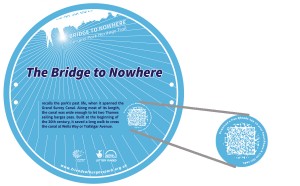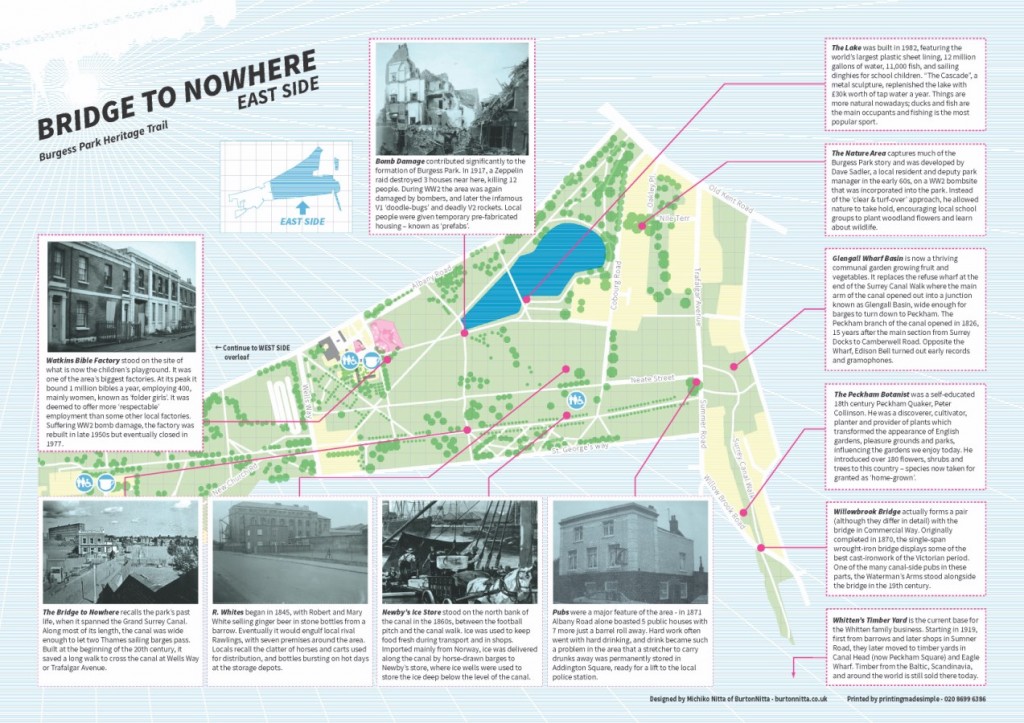
Take the Heritage Trail!
- Click on the interactive map below
- Walk the park and smartphone-scan the QR codes
- Download our map PDFs below
- Use the website menus above
This is the story of Burgess Park – one of London’s biggest parks and the only area in South London to have been de-urbanised.
Burgess Park’s significance is due not so much to its size but to its history, and the unusual way it was created within our living memory. The park slowly emerged from the space left by demolished factories, churches and streets as well as bomb damaged areas and the filled-in Grand Surrey Canal from Camberwell to Peckham.
The park was inspired by local people like Jessie Burgess who the park is named after, by post-war optimism and by the Abercrombie Plan – a grand plan to rebuild London in the 1940s. The aim of the park was to create a ‘green lung’ for South London.
The Friends of Burgess Park who want to protect, promote and enhance this important inner-city London park, hope that, with the benefit of Lottery Funding, the park’s heritage will be remembered.
Uncover the park’s intriguing history with our Burgess Park Heritage Trail – from rich farmland and market gardens supplying London’s growing population during the 18th century to the 19th/20th century sprawl of industries with its busy streets, shops, pubs and people.
On the map – hover over a marker to see the subject; click the image to go to the relevant page:
The park contains four listed buildings: St George’s Church, the Lime Kiln, Chumleigh Gardens and Passmore Edwards Library, Baths and Wash-house, (which also has a listing for its railings!). The park also holds many other clues to its interesting past. So as you walk, run or cycle through be on the lookout for our heritage plaques:
Each plaque tells a story and by scanning the QR code you can uncover the hidden stories of Burgess Park (you may need to install a free QR app on your mobile device).
To enjoy this fascinating story you can download the two-part heritage trail map:
If you find any inaccuracies or if you would like to make a contribution to the historical record please contact us at friendsofburgesspark@gmail.com, Alternatively – many people are adding their memories now to each page. Scroll to the bottom and add your own comments, questions or memories.
We believe we have permission to use the images you will find on this website. However, if you think any of the images infringe copyright please let us know at friendsofburgesspark@gmail.com
More historical links:
https://www.youtube.com/channel/UCAL7jS-W6jiRLCYxlh1fdNw – Four clips of oral history produced by the Bridge to Nowhere Project (links are also in specific pages)
https://londoncanals.uk/ (An introduction to the Surrey Canal) https://londoncanals.uk/historical/the-grand-surrey-the-canal-that-aimed-for-portsmouth/
Also see our links page



My 4 times Great Grandmother died in 1863 at Charles street now part of Burgess park. Amazing how this area has been converted.
Lee – Australia
Hi. I just found the link to the Street. Thank you for putting this page together. An ancestor of mine was killed in the 19 Oct ’17 Zeppelin bombing. Stephen John Skelton was only 15. I am named in memory of him. His loss deeply effected the family.
My name is Hugo van Willigen. I live in Australia and I am a book restorer.
I have been asked to work on a bible owned by a gentleman in Adelaide. There was no title page in the bible, only a sticker ‘Watkin Bindery’. The inscription on the inside cover dates 1883. We would both be fascinated to find out more about this Bible Factory.
Can you point the way? Are there factory archives we can access?
Regards, Hugo van Willigen
Dear Hugo – Thanks for your message – it’s interesting to know how far and wide Watkins’work was getting by 1883 or so! Presumably you’ve read the page here on the Watkins works. It has a number of comments from a number of people who worked there until it closed in the 1970s. Maybe they could fill you in on more details than we’ve been able to research for the page? I could put you in touch, if you select one or two people?
Hello Hugo. I lived in Camberwell SE, London, from the ’40s until end of ’60s, and there was a Watkins bible factory in Old Kent Road. This was well-known to the people around here. I now live in E. Sussex, so do not know if this factory is still here. In one of my books, from the borough studies library, there is a photo of many local people who worked there.
Good luck in your quest of finding out more on this.
Sheila Bearman
I grew up in Gloucester Grove, just off at George’s Way. There were many properties bomb damaged from the war. Most properties would have been considered slums – no bathroom and an outside toilet. Many properties housed more than one family when properties were requisitioned to house people displaced from their property being destroyed by the bombings during the blitz. My mother’s house in Nutt Street was destroyed when the house took a direct hit, killing her mother, brother in law and seriously injuring her sister. Mum was 17 at the time. I went to Gloucester Primary School and have good memories of my time there. I moved school at 11 (that was 1959). I stayed in the area into my 20s. There was a lot of poverty in the area but was a good community to live in with local shops in St George’s Way supplying most needs. We had a weekly visit to the bath-house. I visited the area about 20 years ago and was overwhelmed to see how much had changed. Burgess Park seemed vast and has taken the place of hundreds of properties which had been destroyed for the “slum clearance”.